The literature review will feed a comprehensive desk research dedicated to identify existing national and regional longitudinal data on students’ learning outcomes. The mapping will cover 32 countries in total: all EU Member States (27) and European Economic Area associated countries (Iceland, Liechtenstein and Norway) plus UK, given the strong focus that Anglo-Saxon countries have had on longitudinal data and surveys in education.
The mapping follows a ‘funnel strategy’ and it is based on the following three steps:
A web-based questionnaire to be delivered to EU experts in education to identify existing longitudinal data
A web-based search to collect specific information on existing longitudinal data
An analysis of the retrieved longitudinal databases to assess their strengths and weaknesses and carry out a comparative analysis of their findings.
Web-based questionnaire to key stakeholders
Researchers web-search first mapping (online form)
Detailed mapping
Analysis of the quality of the retrieved longitudinal databases (e.g. assess strengths-weaknesses, harmonize data where possible, carry out a comparative analysis of findings).
Anywhere
Any longitudinal data (same cohorts) on students’ learning outcomes, such as performance and cognitive development
32 countries
Depending on 1 but nost likely standardised tests (also ‘repeated cross-sectional ones but no international comparative assessments)
At least LINEup countries (6)
Depending on 1 and 2
Possible customised strategy
(by country)
Feasibility
study
Research report & infographic
A feasibility study will be carried out to understand to what extent an equivalent to the database homogenisation process adopted elsewhere for longitudinal data (i.e. the LIS – Luxembourg Income Study) can be replicated for education data, as an extremely useful tool for the community of researchers interested in comparative analyses.
The results of the mapping will be published on the project website through an open source interactive map that will allow researchers the wider public to understand what longitudinal data are available and where and the community of researchers to access more easily the different databases.


